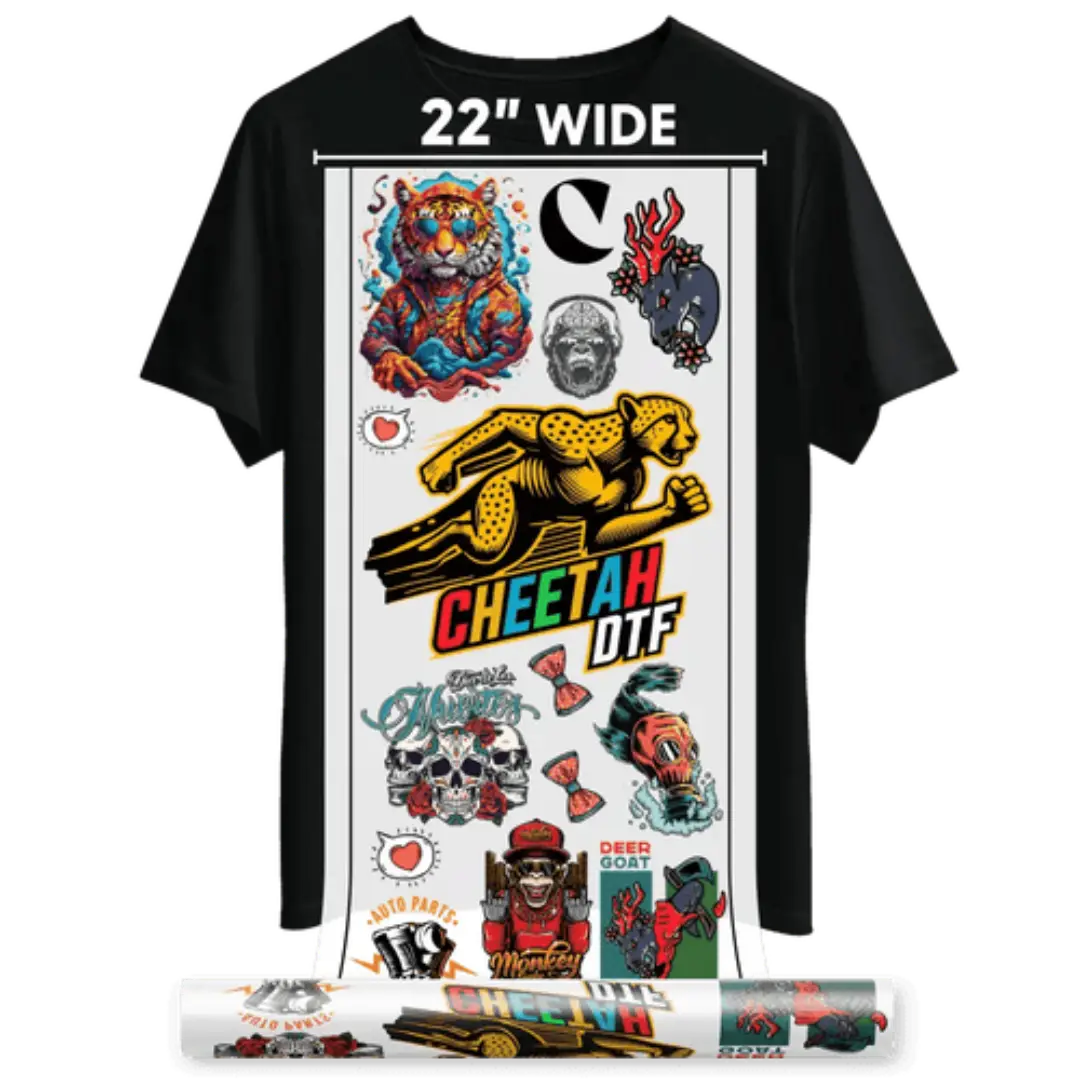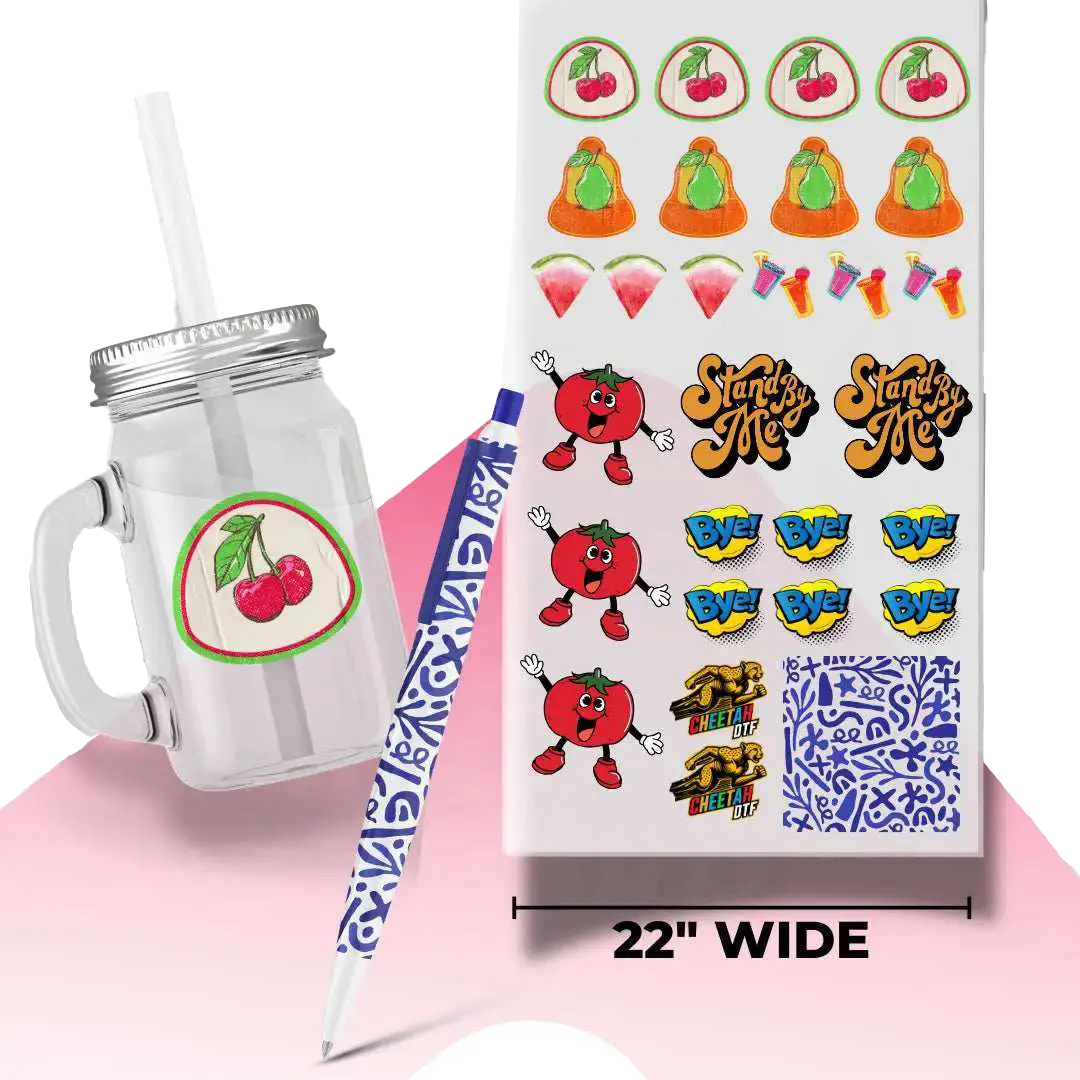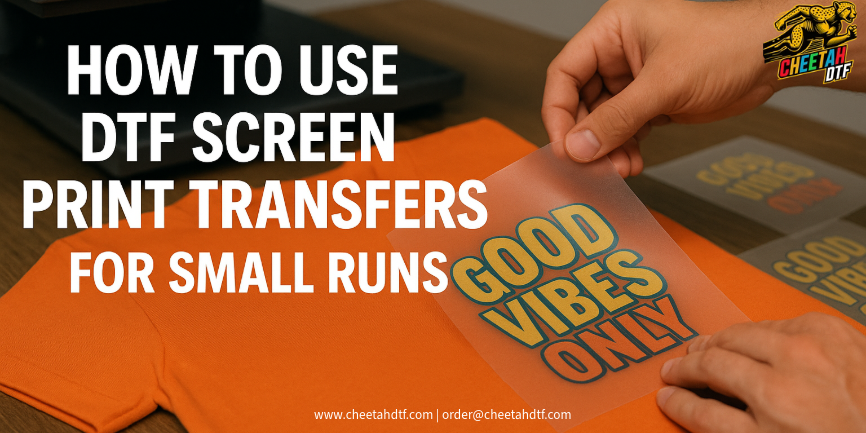How to Use DTF Screen Print Transfers for Small Runs
If you work in the custom clothes industry, whether you own a small business, sell on Etsy, or simply enjoy making imaginative ideas a reality, you are aware of how difficult it can be to print a limited number of superior shirts using custom DTF transfers. Screen printing the old-fashioned way?
It is excellent for large orders but not so much for smaller ones due to the high art fees involved. DTF (Direct-to-Film) screen print transfers are helpful in this situation. They simplify creating eye-catching, expert patterns without the trouble or expense of large quantities.
Versatility and Benefits of Custom DTF Transfers
Custom DTF transfers are particularly beneficial for small runs as they offer versatility for various fabric types and hard surfaces, with no minimums or setup fees, allowing for intricate detail in design.
This guide’ll explain how to use DTF screen print transfers for small runs, from the tools you’ll need to the step-by-step process. We'll also provide free tips to help your prints come out clean, crisp, and ready to impress.
What Are DTF Screen Print Transfers?
DTF screen print transfers are revolutionizing the custom printing industry. DTF lets you print your design directly onto a unique film utilizing water-based inks, eliminating the time-consuming and tedious setup required for traditional screen printing. After a brief heat press, that design magically transfers onto your fabric, resulting in a beautiful matte finish.
In the DTF transfer process, a powder adhesive is applied to the printed film, which helps create a strong bond with various fabric types. This enhances the durability and vibrancy of the printed designs while providing a soft hand finish.
What makes it so amazing? Large quantities or highly qualified workers are unnecessary to create complex, colorful, and excellent designs. It’s a state-of-the-art, efficient way to get professional results, especially for small-scale or one-time projects.
Why Use DTF Transfers for Small Runs?
Small orders come with big expectations. Every piece must look flawless, whether you're printing for a personalized gift shop, a school function, or a boutique brand. DTF is perfect for small runs for the following reasons:
Minimal Setup Time
Traditional screen printing involves setting up multiple screens, especially for multi-color designs. DTF cuts that time to near zero, even under heavy pressure during the application. Just print, press, and go.
Versatile Fabric Compatibility
DTF works on cotton, polyester, polyester blends, and even more complex textiles, so your design need not be limited to one fabric type.
Exceptional Print Quality
Enjoy high-quality, durable prints with bright colors that hold their vibrancy and detail through multiple washes.
Cost-Effective for Low Volumes
There are no screen fees, color separations, or minimum orders. You can even print just one shirt and still make a profit.
Vibrant, Durable Prints
DTF produces a durable print with a soft hand feel, vibrant color design, and resistance to fading or cracking.
Opacity is crucial in achieving vibrant and durable prints, especially on dark fabrics. It ensures the ink layer is thick enough to maintain the design's brightness and clarity.
Creating Custom Designs
Creating custom designs for DTF transfers opens up possibilities for custom apparel and promotional products. The beauty of DTF transfers lies in their ability to produce full-color designs with vibrant colors and fine details, making them a game-changer for small businesses and individuals alike.
Smart DTF Printing
When designing for DTF transfers, it’s crucial to consider the color of the garment you’ll be printing on. The print may appear differently on light or dark fabrics, so plan your design accordingly. Using CMYK values ensures accurate color representation, allowing you to achieve vivid colors and spot colors that stand out.
Sharp, Durable, and Colorful Prints
DTF transfers are perfect for creating intricate designs with multiple colors, offering a level of detail and vibrancy that traditional screen printing can’t match. Whether you’re designing for a single custom shirt or a small batch of promotional items, DTF transfers provide an easy application process and durable results that will impress your customers with their fine details.
Design Preparation
Preparing your design before printing ensures the best possible outcome with DTF transfers. First, make sure your art file is in the correct format, such as JPEG, PNG, or TIFF, and has a high resolution of at least 300 DPI. This ensures that your design will be crisp and clear when printed.
Design in CMYK Color
Creating your design in CMYK color mode is crucial for accurate color representation. While DTF transfers can produce a wide range of colors, it’s essential to understand the color limitations and how they might affect your final print. Testing your design before full production can help you identify any issues and make necessary adjustments.
Transfer Paper
Using transfer paper and heat presses can also impact the final result. Reputable suppliers like Transfer Express offer guidelines and resources for design preparation, including tips on creating full-color designs and working with multiple colors. By following these guidelines, you can ensure that your custom apparel and promotional products look their best.
Essential Supplies to Get Started
To get the best results from DTF printing for small runs, you’ll need:
- DTF Transfers: Printed in-house or ordered from a trusted provider like Cheetah DTF.
- DTF Transfer Film: The medium where your artwork is printed before transfer.
- Heat Press Machine: Ensure it offers accurate temperature and pressure control.
- Lint Roller: For pre-press fabric prep.
- Teflon Sheet or Parchment Paper: Used for final press and improved finish.
- Garments: T-shirts, hoodies, tote bags, etc.
The heat press machine plays a crucial role in the DTF transfer process. It utilizes heat transfer to bond the printed designs to the fabric, ensuring durability and color vibrancy in the final product.
How to Use DTF Screen Print Transfers for Small Runs: Step-by-Step Guide
Here’s a simple process that even beginners can follow to create professional-quality prints with DTF:
1. Prepare the Garment
Place your cloth flat on the heat press and pre-press it at 300°F (149°C) for five seconds. This stage eliminates creases and moisture to help the transfer adhere uniformly.
Use a lint roller to remove dust or fibers, clean surfaces mean better adhesion and print quality. The adhesive used in the DTF transfer process requires a clean surface to form a strong bond with the fabric.
2. Align Your DTF Transfer
Place your DTF transfer film on the area of the garment where you want the design to show. The printed side should be facing up. Always align the design correctly, especially for logos or centered text.
3. Heat Press Settings
Set your press to:
- Temperature: 300°F–320°F (149°C–160°C)
- Pressure: Medium to firm
- Time: 10–15 seconds
Lower the press and allow it to run for the full cycle without shifting.
4. Let It Cool and Peel
After pressing, wait for the garment to cool. DTF is typically a cold peel process. Rushing this part can lead to tearing or uneven transfer. Once cool, peel the film slowly and evenly to reveal the vibrant, high-quality design beneath.
5. Final Press for Durability
Cover the design with a Teflon sheet or parchment paper and do a final press for 5–10 seconds. This enhances the bond between ink and fabric, creating a durable print with a smooth finish.
Tips for Maximizing Quality in Small Runs
When printing in small quantities, quality control is everything. Here’s how to get consistent, professional results:
Always Test First
Before running your whole order, press one sample pack. This allows you to confirm placement, color, and sizing. Consider offering free samples for testing to ensure satisfaction before full production.
Keep Transfers Flat and Clean
Store your DTF transfers in a cool, dry place away from direct sunlight. Keep them flat to prevent curling.
Offer Customization
One of the most significant benefits of DTF for small runs is easy customization. Let customers personalize names, logos, or color designs without added cost.
Easy View and Design
To make the design process as smooth as possible, use design software that supports layers and allows for easy editing and manipulation of your art file. This will help you make precise adjustments and ensure your design is perfect before printing.
Templates and Pre-Made Designs
Consider using a template or a pre-made design to simplify the process and ensure accurate placement of the design on the garment. This is especially useful when working with multiple designs or bulk orders.
Designing Factors for DTF Transfers
When designing for DTF transfers, consider the settings of your heat press machine, including the temperature and heat transfer pressure required to apply the transfer to different-colored garments. These factors can significantly affect the outcome, so getting them right is essential.
Ideal for Custom Apparel
Using a gang sheet can help streamline the production process, allowing you to print multiple designs on a single sheet and save time and materials. DTF transfers offer a durable and long-lasting finish, making them ideal for custom apparel and promotional products that require repeated washing and wear.
DTF vs. Screen Printing: What’s Best for You?
|
Feature |
DTF Transfers |
Screen Printing |
|
Setup Time |
Minimal |
Extensive |
|
Cost for Small Orders |
Low |
High |
|
Ideal for Custom Orders |
Yes |
No (requires bulk to be viable) |
|
Design Complexity |
Handles multi-color designs |
A setup is needed for each color |
|
Suitable for Small Runs |
Perfect |
Not cost-effective |
|
Fabric Compatibility |
Cotton, polyester, blends |
Mostly cotton |
|
Durability |
High (with post-press) |
High |
In short, DTF screen print transfers are a dream come true for short runs, custom orders, and fast turnarounds. Screen printing still has its place, but not when printing 10 shirts with four colors each. Additionally, for small businesses in the custom t-shirt business, choosing DTF transfers can significantly enhance quality, efficiency, and profitability by allowing for vivid colors.
Who Should Use DTF for Small Runs?
Here are some real-world scenarios where DTF is the perfect match:
Independent Brands
Testing new merch ideas? DTF lets you run limited editions without breaking the bank.
Artists and Designers
Bring your artwork to life with precise, colorful, and professional-grade heat transfer DTF transfers.
Event Organizers
Do you need just 20 shirts for a corporate event or reunion? No problem. DTF makes it fast and easy.
Etsy and E-commerce Sellers
Offer personalized apparel with rapid fulfillment and no minimum order limits. Customers can easily upload their designs for custom orders, specifying the exact size and using features like the Custom Gang Sheet Builder to arrange their art seamlessly.
Common Mistakes to Avoid
Even though DTF is beginner-friendly, here are some pitfalls to steer clear of:
Pressing Too Hot
Stick to recommended temps. Overheating can melt film or distort your design.
Peeling Before Cooling
Always let the garment cool completely before peeling. Warm peel leads to poor results.
Skipping the Final Press
That extra 5 seconds of post-press ensures a durable print that stands the test of time.
Low-Quality Film
Cheap film transfers may crack, fade, or peel prematurely. Invest in quality suppliers. Note that low-quality film can lead to issues such as cracking or splitting, which can significantly affect the durability of the print.
Caring for DTF-Printed Apparel
Provide customers with simple care instructions to help preserve the print quality:
- Wash inside out
- Cold water wash (gentle cycle)
- Air dry or low tumble
- Do not bleach or iron over the print
DTF prints can last through 50+ washes with proper care without losing their pop. Following these instructions is crucial to maintaining the printed image quality, as the uploaded image will be printed without resizing.
Where to Get High-Quality DTF Transfers
Not all DTF transfers are created equal. If you want vibrant colors, crisp lines, and long-lasting quality, choose suppliers specializing in DTF screen print transfers for small businesses.
Top Recommendations
Cheetah DTF is fast, affordable, and excellent for short runs with top-tier customer service. Look for services that allow bulk ordering and no minimum custom prints, especially those that use a gang sheet. That flexibility is what makes DTF such a game-changer.
Ordering and Production
Consider the quantity and size required for your project when ordering DTF transfers. Many suppliers offer bulk discounts, which can help you save money on larger orders. Ensure that your art file is in the correct format and resolution and that your design is prepared according to the supplier’s guidelines.
Reputable suppliers like Transfer Express offer fast shipping and no minimum orders, making it easy to get started with DTF transfers. Depending on the supplier and the complexity of your design, the production process typically takes a few business days.
Best Outcome
To ensure the best possible outcome, follow the supplier’s instructions for application, including the use of heat presses and transfer paper. You can even use a home iron to apply the transfers for small orders or samples. By following these steps, you can achieve professional-quality results with DTF transfers, whether you’re creating custom apparel, promotional products, or decorative items.
Why DTF Just Makes Sense
Switching to DTF feels like a breath of fresh air if you’ve ever spent hours burning screens or stressing over color alignment. Its modern printing is easy, quick, clean, and completely beginner-friendly. For anyone chasing custom, small-run perfection, DTF is the upgrade your workflow’s been waiting for.
Sustainability and Smart Printing
DTF is not just efficient, it’s also better for the planet. With traditional printing, you often overproduce or waste ink, fabric, and time during setup. Traditional printing frequently results in overproduction or waste of cloth, ink, and setup time. You can print what you need, when needed, with DTF transfers.
This lessens energy use, textile waste, and overstock, all of which are critical if your brand is environmentally responsible and aims to use light resources.
Summing it Up
In a world that demands more personalization, faster turnaround, and better quality, DTF screen print transfers are the solution for small batch printing. They provide beautiful results on various surfaces, are inexpensive, and are simple to use, allowing users to upload their designs easily.
The answer to the question of how to use DTF screen print transfers for small runs is straightforward. With the correct method and provider, anyone can produce prints of professional quality regardless of order quantity.
Launch Bold Designs with Cheetah DTF Transfers
Whether launching your first shirt design, printing merch for a local event, or running an e-commerce store, start strong with Cheetah DTF. Their wide range of DTF transfers is tailored for creators who want to print smarter, not harder.


